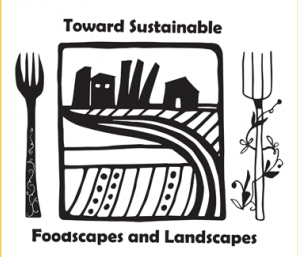Guest Blog: Erin Nelson, Postdoctoral Fellow, University of Guelph
Institute for Community Engaged Scholarship / Research Shop
On Monday, June 24th, Nick Saul – co-author of The Stop: How the Fight for Good Food Transformed a Community and Inspired a Movement – came to Guelph for the official launch of his book. The event was held at Lakeside Hope House, and was sponsored by the Guelph Neighbourhood Support Coalition, the Guelph & Wellington Task Force for Poverty Elimination, the Guelph-Wellington Food Round Table, The Bookshelf, Community Food Centres Canada, and Random House.
It was a steamy evening, but more than 150 people braved the heat to come hear Nick tell the story of The Stop. He spoke passionately about shifting from a charity-based model of fighting hunger to one that recognizes the dignity of all people, and the empowering, healing, and unifying potential of food. He explained how the Community Food Centre movement can help turn that ideal into reality, by creating physical spaces for people to connect over food, by growing it, learning about it, sharing and celebrating it. He also encouraged the audience to politicize food, and advocate for food system change not just as consumers, but as citizens. Using the history of labour rights – such as the weekend – that were fought for and won as an example, he argued that we need to become “food fighters” in order to make change happen in our communities.
The message sparked an engaging Q&A session that probably could have continued all night long had it been allowed to (and had Nick not needed to get home to Toronto). The discussion was moderated by Brendan Johnson, Executive Director of the Guelph Neighbourhood Support Coalition. Brendan is also a member of The Seed Community Food Hub Committee – a Poverty Task Force working group aiming to build a community food hub in Guelph-Wellington. The night served as an opportunity to share some of the work that The Seed has been doing over the past two years to support changes to the local emergency food system, and to introduce the group – and its vision – to the wider community.
After the formal part of the evening was over, people gathered in the Hope House café to continue the conversation (and buy signed copies of Nick’s book). Even without air conditioning the room buzzed with energy until well after 9pm, as people chatted with Nick and with each other about a wide range of topics, including what a community food hub might look like in Guelph-Wellington. Members of The Seed – including the Poverty Task Force, the Food Round Table, Wellington-Dufferin-Guelph Public Health, the Guelph Community Health Centre, and the University of Guelph’s Research Shop – were on hand with information about their work, and with a sign up sheet for people interested in getting involved with the initiative. Of course there was also excellent food for everyone to enjoy, provided by local businesses Green Table Foods and With the Grain.
By the end of the evening there was no doubt that people had been inspired and energized by the talk, and by the discussions and exchange that happened afterwards. At one point during the night, Nick mentioned that he saw no reason why there couldn’t be a community food centre one day in Guelph-Wellington. Surely many of those who were in the room left thinking about the role they could play in making that happen.
If you’re interested in receiving updates about The Seed Community Food Hub Committee and getting involved in its work, please contact info@gwpoverty.ca.





